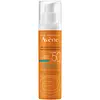What's inside
What's inside
 Key Ingredients
Key Ingredients

 Benefits
Benefits

 Concerns
Concerns

 Ingredients Side-by-side
Ingredients Side-by-side

Water
Skin ConditioningC12-15 Alkyl Benzoate
AntimicrobialMethylene Bis-Benzotriazolyl Tetramethylbutylphenol
UV FilterDiisopropyl Adipate
EmollientIsodecyl Neopentanoate
EmollientSilica
AbrasiveDicaprylyl Carbonate
EmollientBis-Ethylhexyloxyphenol Methoxyphenyl Triazine
Skin ConditioningDiethylhexyl Butamido Triazone
UV AbsorberAluminum Starch Octenylsuccinate
AbsorbentButyl Methoxydibenzoylmethane
UV AbsorberPotassium Cetyl Phosphate
EmulsifyingDecyl Glucoside
Cleansing1,2-Hexanediol
Skin ConditioningC10-18 Triglycerides
EmollientGlyceryl Laurate
EmollientVp/Eicosene Copolymer
Acrylates/C10-30 Alkyl Acrylate Crosspolymer
Emulsion StabilisingBenzoic Acid
MaskingButylene Glycol
HumectantCaprylic/Capric Triglyceride
MaskingDisodium EDTA
Parfum
MaskingGlyceryl Behenate
EmollientGlyceryl Dibehenate
EmollientGlyceryl Stearate
EmollientOxothiazolidine
Skin ProtectingPEG-100 Stearate
Propylene Glycol
HumectantSodium Benzoate
MaskingTocopherol
AntioxidantTocopheryl Glucoside
EmollientTribehenin
EmollientXanthan Gum
EmulsifyingZinc Gluconate
Skin ConditioningWater, C12-15 Alkyl Benzoate, Methylene Bis-Benzotriazolyl Tetramethylbutylphenol, Diisopropyl Adipate, Isodecyl Neopentanoate, Silica, Dicaprylyl Carbonate, Bis-Ethylhexyloxyphenol Methoxyphenyl Triazine, Diethylhexyl Butamido Triazone, Aluminum Starch Octenylsuccinate, Butyl Methoxydibenzoylmethane, Potassium Cetyl Phosphate, Decyl Glucoside, 1,2-Hexanediol, C10-18 Triglycerides, Glyceryl Laurate, Vp/Eicosene Copolymer, Acrylates/C10-30 Alkyl Acrylate Crosspolymer, Benzoic Acid, Butylene Glycol, Caprylic/Capric Triglyceride, Disodium EDTA, Parfum, Glyceryl Behenate, Glyceryl Dibehenate, Glyceryl Stearate, Oxothiazolidine, PEG-100 Stearate, Propylene Glycol, Sodium Benzoate, Tocopherol, Tocopheryl Glucoside, Tribehenin, Xanthan Gum, Zinc Gluconate
Water
Skin ConditioningHomosalate
Skin ConditioningPolymethylsilsesquioxane
Butyl Methoxydibenzoylmethane
UV AbsorberEthylhexyl Salicylate
UV AbsorberOctocrylene
UV AbsorberAlcohol Denat.
AntimicrobialTapioca Starch
Phenylbenzimidazole Sulfonic Acid
UV AbsorberCyclomethicone
EmollientBehenyl Alcohol
EmollientCetearyl Alcohol
EmollientMethylpropanediol
SolventSilica Dimethyl Silylate
EmollientGlycerin
HumectantCarnitine
CleansingGlycyrrhetinic Acid
Skin ConditioningGlycyrrhiza Inflata Root Extract
Skin ConditioningSodium Stearoyl Glutamate
CleansingAcrylates/C10-30 Alkyl Acrylate Crosspolymer
Emulsion StabilisingCarbomer
Emulsion StabilisingXanthan Gum
EmulsifyingSodium Hydroxide
BufferingSodium Chloride
MaskingTrisodium EDTA
Ethylhexylglycerin
Skin ConditioningPhenoxyethanol
PreservativeWater, Homosalate, Polymethylsilsesquioxane, Butyl Methoxydibenzoylmethane, Ethylhexyl Salicylate, Octocrylene, Alcohol Denat., Tapioca Starch, Phenylbenzimidazole Sulfonic Acid, Cyclomethicone, Behenyl Alcohol, Cetearyl Alcohol, Methylpropanediol, Silica Dimethyl Silylate, Glycerin, Carnitine, Glycyrrhetinic Acid, Glycyrrhiza Inflata Root Extract, Sodium Stearoyl Glutamate, Acrylates/C10-30 Alkyl Acrylate Crosspolymer, Carbomer, Xanthan Gum, Sodium Hydroxide, Sodium Chloride, Trisodium EDTA, Ethylhexylglycerin, Phenoxyethanol
 Reviews
Reviews

Ingredients Explained
These ingredients are found in both products.
Ingredients higher up in an ingredient list are typically present in a larger amount.
Acrylates/C10-30 Alkyl Acrylate Crosspolymer is a synthetic polymer. It is used to thicken and improve the texture of products. Due to its properties, it can prevent water and oil ingredients from separating.
Also known as Avobenzone, this ingredient is a chemical sunscreen filter that provides protection in the UV-A range.
Avobenzone is globally approved and is the most commonly used UV-A filter in the world.
Studies have found that avobenzone becomes ineffective when exposed to UV light (it is not photostable; meaning that it breaks down in sunlight). Because of this, formulations that include avobenzone will usually contain stabilizers such as octocrylene.
However, some modern formulations (looking at you, EU!) are able to stabilize avobenzone by coating the molecules.
Avobenzone does not protect against the UV-B range, so it's important to check that the sunscreen you're using contains other UV filters that do!
The highest concentration of avobenzone permitted is 3% in the US, and 5% in the EU.
Learn more about Butyl MethoxydibenzoylmethaneWater. It's the most common cosmetic ingredient of all. You'll usually see it at the top of ingredient lists, meaning that it makes up the largest part of the product.
So why is it so popular? Water most often acts as a solvent - this means that it helps dissolve other ingredients into the formulation.
You'll also recognize water as that liquid we all need to stay alive. If you see this, drink a glass of water. Stay hydrated!
Learn more about WaterXanthan gum is used as a stabilizer and thickener within cosmetic products. It helps give products a sticky, thick feeling - preventing them from being too runny.
On the technical side of things, xanthan gum is a polysaccharide - a combination consisting of multiple sugar molecules bonded together.
Xanthan gum is a pretty common and great ingredient. It is a natural, non-toxic, non-irritating ingredient that is also commonly used in food products.
Learn more about Xanthan Gum